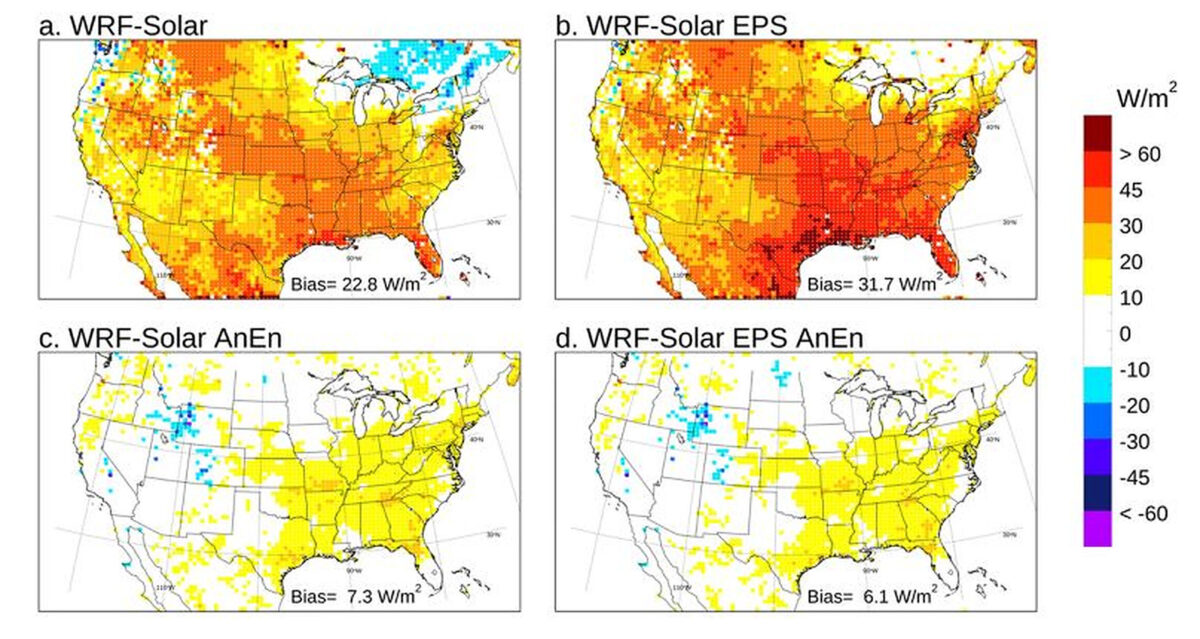Researchers from China have assessed the accuracy of the WRF-Solar model in simulating global and diffuse radiation, pointing to its sensitivity to aerosol optical depth (AOD), cloud optical thickness (COT), and solar zenith angle (SZA).
The Weather Research and Forecasting (WRF) model was developed in 2016 within the Sun4Cast project funded by the US Department of Energy. The model is in the public domain and can be downloaded from the official WRF Github repository.
“Since the release of WRF-Solar, its performance in the simulation of diffuse radiation in localized regions in China and sensitivity to atmospheric parameters have not been fully explored,” the research group said. “This study aimed to test the simulation accuracy of WRF-Solar for global and diffuse radiation using satellite-based aerosol optical properties, which were obtained from a moderate resolution imaging spectroradiometer.”
The WRF model is widely used for weather forecasting. It uses the Rapid Radiative Transfer Model for Global Climate Models (RRTMG) scheme as shortwave radiation input, and the WRF-Dudhia as a radiation scheme. Additionally, the WRF-Solar model uses AOD input for its predictions, while WRF-Dudhia does not.
In their mission to emphasize the sensitivities of the WRF-Solar model, the academics have compared its predictions with real-life observations measured at Wuhan University. As for the AOD sensitivity, the researchers found that simulation error gradually decreased with the increase in the AOD. The parameter measures the scattering and absorption of light by tiny particles, or aerosols, in the atmosphere.
“The standard deviations of simulation errors corresponding to three different AOD ranges, of less than 0.4, between 0.4 and 0.8 and greater or equal to 0.8, were 162.12, 158.15 and 135.45 W m-2 of diffuse radiation, respectively,” they said. “However, when the AOD is greater or equal to 0.8, the model overestimated the diffuse radiation, with an average bias of 58.57 W m-2.”
Popular content
As for COT, which measures how effectively a cloud layer scatters and absorbs sunlight, the researchers found the error to decrease with a COT increase. The standard deviations of the bias corresponding to COT range lower than 20, between 20 and 40, between 40 and 60, and more significant than 60, reaching 173.40, 149.45, 133.84, and 99.11 W m-2, respectively.
The scientists also looked at the dependence of WRF-Solar error on the SZA. “The simulation error increased as the SZA decreased,” they said. “When SZA <30 degrees, very discrete biases of simulated diffuse and global radiation were observed, with standard deviations of the bias of 245.40 and 286.65 W m-2 and mean differences of 79.20 and -3.62Wm-2, respectively. However, when SZA is between 50 and 70 degrees, the biases of simulated diffuse and global radiation were small, with standard deviations of 136.90 and 121.77 W m-2, respectively.”
However, comparing WRF-Solar to WRF-Dudhia, the researchers found the former to be superior. “In general, the improved WRF-Solar provides highly accurate forecasts in clear conditions. Under all-sky and cloudy conditions, poor comparison results of WRF-Solar and the traditional WRF model were obtained, and the simulated global solar radiation was largely overestimated.”
Their findings are available in the study “Assessment of the high-resolution estimations of global and diffuse solar radiation using WRF-Solar,” published in Advances in Climate Change Research. Concluding the article, the research group has emphasized the “need for improved representation of clouds and circulation in the model through physical parameterization and enhancements of satellite cloud and aerosol data assimilation techniques.”
The team included academics from China University of Geosciences and Hubei Luojia Laboratory.
This content is protected by copyright and may not be reused. If you want to cooperate with us and would like to reuse some of our content, please contact: editors@pv-magazine.com.


By submitting this form you agree to pv magazine using your data for the purposes of publishing your comment.
Your personal data will only be disclosed or otherwise transmitted to third parties for the purposes of spam filtering or if this is necessary for technical maintenance of the website. Any other transfer to third parties will not take place unless this is justified on the basis of applicable data protection regulations or if pv magazine is legally obliged to do so.
You may revoke this consent at any time with effect for the future, in which case your personal data will be deleted immediately. Otherwise, your data will be deleted if pv magazine has processed your request or the purpose of data storage is fulfilled.
Further information on data privacy can be found in our Data Protection Policy.